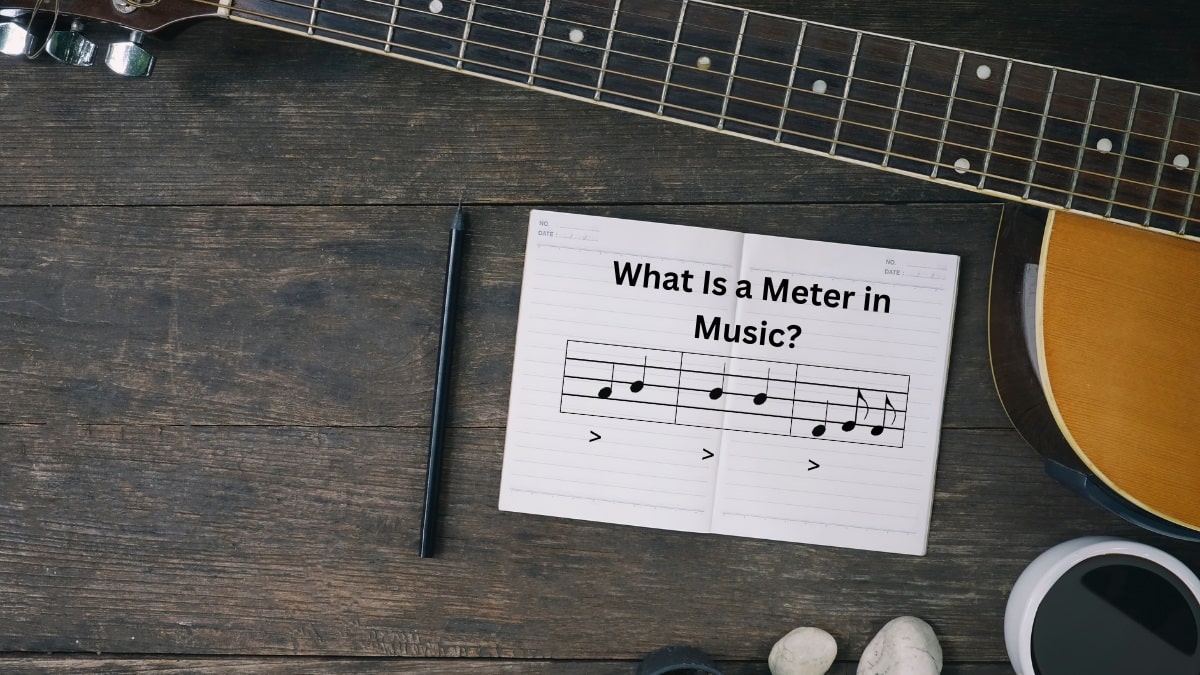The movie That Thing You Do is a story about a local band creating their very first hit song. In one of the scenes, the band performs this song, but the drummer goes too fast with the beat! The lead singer is livid, the bass guitarists are confused, but the audience comes alive.
In fact, it wasn’t just the speed that was going too fast. The song evidently had a new meter. And instead of its previous mundane and boring mood, the very same tunes became a sensation.
In this article, we explore every aspect of what is meter in music. In addition, we’ll go through some of the most popular songs, and demonstrate how meter plays out in their overall structure.
So What Exactly is Meter in Music?
Meter in music is among the hardest concepts to define! But it gets easier if you think about its origins. It’s actually borrowed from the world of poetry, where it describes the length of verses, the number of syllables, and where the emphasis on each syllable lies.
The same thing happens with music. The meter is the number of beats between the start and end of a repeatable pattern of pulses. Usually, it’s recognizable by the onset of an accent or intense beat.
Meter in the Step, the Dance, the Song, and the Music

In the military or in martial arts, it’s quite customary to hear the counts of “One, Two, One, Two”, referring to the way the troops should march. No one ever gets out of line. In Judo, you’d see a choreographed sequence of one to ten, with every count from the sensei meaning progress in a complex move.
The same applies to ballet, Hip-Hop dance, waltz, tango, and any other dance you can think of. There’s always a distinct count of “ONE, two, three four, ONE, two, three, four, ONE, two, three, four, …etc”. The counts might differ, and the meter might be a simple “One, Two”, like a march, or a far more complicated sequence like “One, two, three, four, five, One, two, One, two, three, four, five”.
A band of three players would also start with a count. Usually using the sticks of the drum, as it’s customary for the drummer to keep the beat. Otherwise, the whole song goes into disarray.
Keeping the meter in an orchestral setting is far more complicated, but the conductor usually manages with the calculated waves of his stick. Simple meters are often easier to do, but the complicated meters are far more interesting.
Meter is a joint venture between movement and sound. They’re completely intertwined, and thinking of meter in the context of music or song alone, usually comes out lacking. The best performer of tango is the one who can visualize it as a passionate dance, with swaying movements.
Common Time, and Other Time Signatures
Keeping regular time in talking, walking, dancing, singing, or playing music is imperative to delivering a good performance. Glitches sometimes happen, and when they do, the nice flow falls apart, and whatever we’re doing comes across as erratic.

When we apply the concept of timing in music, we can start with a very simple premise: music is a progression of notes through time. Their passage can be slow and languid, or quick and hasty. And even as these notes move on, they can progress in a simple pattern, or do a complicated one.
Keeping time and maintaining a proper meter depends on the beat, bar, measure, and phrase. To move on, we’d need to briefly define what each one of these terms means.
Beat
The beat is the closest possible thing to your heartbeat while taking a leisurely walk. You can feel it as a pulse, you can tap it on the table, or you can say it out loud as a count. The beat is the absolute fundamental concept of making music or choreographing a dance.
Just add notes or silences in accordance with these beats and you got yourself a little melody. The way the notes are written already expresses the beat. You can tell whether the sequence is quick, regular, or slow from two things:
- the notes.
- the time signature.
Bar
The bar is a way to give structure to a sequence of notes. It’s one of the most efficient and effective techniques to organize musical notes. Enclosing every 4 or 8 notes within a bar makes the processes of writing or reading music so much easier.
Additionally, a bar represents a little chunk of time. So when we talk about meter, we naturally need to refer to what happens in a particular bar, or sequence of bars.
Measure and Phrase
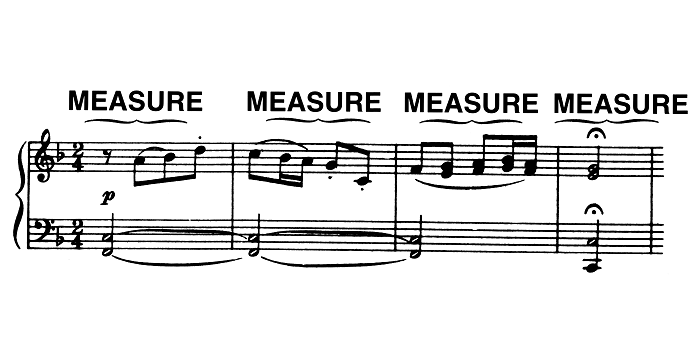
The measure is the single unit of melody in a single bar. If you’d like to compare music to language, then the measure would be the word. And using the same analogy, the phrase would be the closest thing to a complete sentence.
Is there any relationship between the meter and the phrase? Absolutely, and it’s simply this:
- the phrase is the melodic part of a repeated pattern.
- the meter is the rhythmic part of that same pattern.
Common Time
Common time is probably the most popular and prevalent in music. It’s a 4-beat-per-bar sequence, with no irregularities at all. Just a simple repetition of a 4-beat pattern per measure; “One, two, three, four”. It’s so prevalent that you can see it sometimes written in sheet music as just a capital “C”, instead of the standard way of writing time signatures.
This is the time generally used in most music genres. So you can find it in Pop, Folk, R&B, and Rock. Some of the most popular 4/4 songs include Adele’s Rolling in the deep, Elvis Presley’s Can’t Help Falling In Love, and the White Stripes’ Seven Nation Army.
To add something to compare this with, we can take a look at the 3/4, or waltz time. Some of the well-known 3/4 compositions are Doris Day’s Que Sera, Sera, Elvis Presley’s Are You Lonesome Tonight?, and of course, a typical waltz like Chopin’s Waltz in C Sharp Minor (Op. 64 No. 2).
Time Signature
This concept of time signatures looks a lot like mathematics, which makes some people gravitate to music theory, while it sends a bunch of others running off! Actually, it’s a pretty simple notation that sets the tone for the musical piece.
A time signature consists of two numbers written as a fraction. The upper number is the number of beats per measure, or how many beats are contained between every two bars. They could appear then as notes or as silences, and both are considered beats.
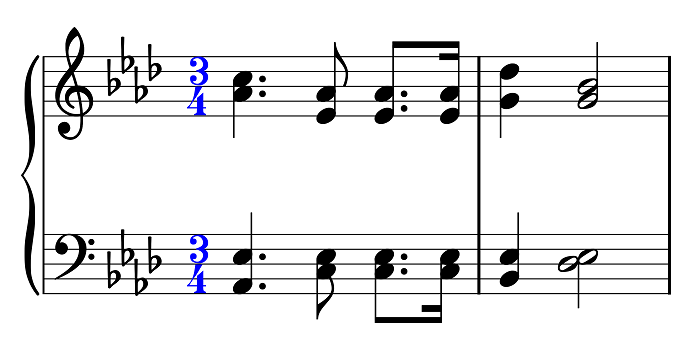
The lower number is the duration of each beat. So a 4/4 signature means that each measure should contain 4 beats, and each one of them should be a quarter note. A 3/4 time signature is a completely different matter, where there are only 3 beats in a measure, with each beat made from a quarter note.
Some people use meter and time signature interchangeably, but that isn’t accurate at all. Time signature describes the number and type of beats in a measure.
On the other hand, meter is all about grouping these beats together in specific comprehensible bundles. Meter starts and ends with an accented beat, and it keeps repeating throughout the musical piece.
Duple, Triple, and Quadruple Meter
Classifying the various meters has to do with two things: movement and mood. For example, composing a march needs to be structured on a “One, two”, or a “One, two, three, four” structure. Simply, because this is the only decent way a military person should walk.
Contrary to that, a waltz should be built on threes. The dance is based on taking three steps then repeating, so grouping the notes into simple sequences of threes, or compound groups of threes is absolutely essential to make the dance possible.
To take these words into the realm of music, a duple is any time signature built on two notes, or two groups of notes. Thus the following time signatures are considered duples: 2/2 – 2/4 – 6/8.
Similarly, triple meters are: 3/4 – 9/8 – 3/2. And quadruple meters are: 4/4 – 12/8 – 4/2.
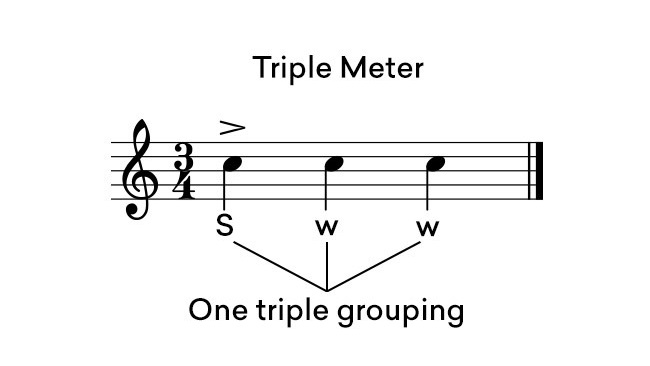
The differences between these meters aren’t always readily clear, especially if they’re both even. A simple duple and quadruple might sound extremely similar, and that’s totally fine. Sometimes, the meter is more helpful to the composer than the audience!
Meter is paramount for choreography and dance, but that’s not all that it’s needed for. Creating mood in any music is highly dependent on the kind of meter used. You can compare a tango, a march, a waltz, and a Hip-Hop dance to visualize the differences.
Simple, Compound, and Irregular Meters
Any note can be played in regular time, in multiples of that time, or in smaller divisions of that time. These duration values translate as a normal pace, a relaxed pace, or a quick pace. The notes can be further grouped into twos, threes, or any other odd combination.
This classification of notes is usually tied up to the degree of complexity of the meter. Thus, the grouping could be simple, compound, or irregular.
Some composers would use a mixture of various meters in a single composition for dramatic effect. This is quite common in operas and film scores. Some familiar examples are 6/8, 9/8, 12/8.
The simple meter, or simple time, happens when the division of the basic is over two. This includes 4/4, 3/4, 2/4, 2/2, 2/1. You might’ve noticed the presence of both common time and cut time in this lineup.
As you’ve already predicted, compound time, or compound meter, is any grouping where the basic note is played over groups of three. Additionally, whenever you see an 8 in the lower part of the time signature, you can also expect the meter to be compound rather than simple.
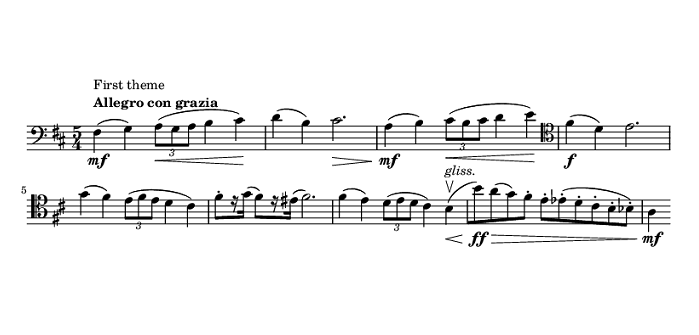
The thing about irregular beats is that they sound familiar at first, then their quirkiness starts appearing.
An example is Tchaikovsky’s Sixth Symphony, also known as the Pathétique. Specifically, in the second movement, where the meter is irregular.
The noticeable three beats in a measure are a lot like a waltz time, but they don’t repeat. Instead, they get elongated or shortened in a totally irregular manner.
An irregular meter is seductive with its unpredictability, but you can’t dance to its beat. Some find this mystique quite charming, while others lean a bit more towards the familiarity of a regular meter.
Who Needs to Know About Meter in Music?
The details of what meter means in musical terms might seem to be too technical, so who can actually benefit from that knowledge? Actually, a lot of people!
- Songwriters are among the folks who should have thorough knowledge about meter. That’s because the meaning in the lyrics might be presented in one meter better than another. And the poetic meter should reflect that.
- Music composers should know all aspects of music theory, but they should always pay attention to the various nuances they could get as they play around different meters.
- Choreographers are also among the most concerned when it comes to meter. Interestingly, a bunch of choreographers play it by ear. But an in-depth knowledge should add sophistication to their work.
- Sound engineers know plenty of technical stuff, and they probably have a general knowledge about what meter and beat is. They might not be terribly affected if they don’t study music theory, but a rudimentary idea on what meter is would certainly reflect on their mixing prowess.
- Finally, music reviewers and even enthusiasts. These folks go deep into the details of songs or film scores. And since meter has a lot to do with mood creation and how far the beat impacts the crowds, then they should definitely know about meter in music.
What is a Meter in Music: Conclusion
Meter is a fundamental aspect of music that describes the rhythmic organization of beats and pulses.
Understanding meter is crucial for composers, songwriters, choreographers, and music enthusiasts alike, as it shapes the structure, feel, and emotional impact of a musical piece.
Whether it’s the familiar common time, the flowing triple meter of a waltz, or the captivating irregularity of an unconventional meter, the concept of meter is interwoven throughout the fabric of music.
Meter truly is the pulse and heartbeat of music. Understanding the nuances of beats, bars, and time signatures can help you gain a deeper appreciation for the complexities and artistry that underlie even the most seemingly simple of melodies.
